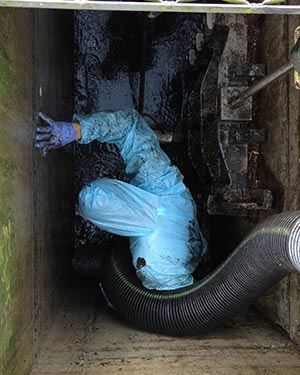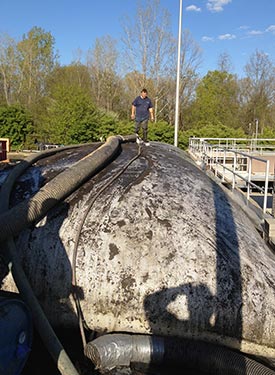
Septic & Sand Systems in Bethel, OH
Why Care for Your Septic System?
Households that are not served by public sewers usually depend on septic systems tank services and systems to treat and dispose of wastewater. A well designed, installed, and maintained septic system from Gullett Sanitation Services, Inc. can provide years of reliable low-cost service. When these systems fail to operate effectively, property damage, ground and surface water pollution, and disease outbreaks can occur. Therefore, it makes good sense to learn how your septic system in Bethel, OH works.
There are many different types of septic system tank systems that can fit a wide range of soil and site conditions. The following information and wastewater services will help you to understand a simple type of septic system, and keep it operating safely at the lowest possible cost. A “conventional” septic systems tank system has 3 working parts:
- The Septic Systems Tank
- The Leachfield with Replacement Area
- The Surrounding Soil
The Septic Systems Tank
The typical septic system tank is a large buried rectangular, or cylindrical container made of concrete, fiberglass, or polyethylene. Wastewater from your toilet, bath, kitchen, laundry, etc. flows into the tank. Heavy solids settle to the bottom, where bacterial action partially decomposes them to digested sludge and gases. Most of the lighter solids, such as fats and grease, rise to the top and form a scum layer.
Septic tanks may have 1 or 2 compartments. 2 compartment tanks do a better job of settling solids and are required for new systems. Tees or baffles are provided at the tank’s inlet and outlet pipes. The inlet tee slows the incoming wastes and reduces disturbance of the settled sludge. The outlet tee keeps the solids or scum in the tank. All tanks should have accessible covers for checking the condition of the baffles and for pumping both compartments. If risers extend from the tank to or above the ground surface, they should be secure to prevent accidental entry into the tank. Solids that are not decomposed remain in the septic systems tank. If not removed by periodic pumping, solids will accumulate until they eventually overflow into the drainfield. Most septic system tanks need to be pumped every 2 to 5 years, depending on the tank size, and the amount and type of solids entering the tank.

Warning Signs of a Failure:
- Odors, Surfacing Sewage, Wet Spots, or Lush Vegetation Growth in the Drainfield Area
- Plumbing or Septic Tank Backups
- Slow Draining Fixtures
- Gurgling Sounds in the Plumbing System
Why a Mound System?
Septic tanks with gravity flow leachfields have been used for many years in areas not served by public sewers. Unfortunately, not all soil and site conditions are well suited for these conventional systems. To protect public health and water quality, alternative systems are often used in areas where conventional systems cannot assure safe sewage treatment. The mound system is 1 alternative, which provides:
- Dosing & Resting Cycles
- Known Level of Sewage Treatment in the Sand Fill before Disposal
- Uniform Distribution of Effluent
- Greater Distance for Effluent to Travel before Reaching Groundwater
A Typical Mound System has 3 Working Parts:
- The Septic Systems Tank
- The Pump Chamber with Pump
- The Mound with Replacement Area
Proper Care Includes:
- Checking the pump chamber, pump, and floats every year and replacing or repairing worn or broken parts. Pump maintenance should follow the manufacturer’s recommendations. Check electrical parts and conduits for corrosion. If the alarm panel has a “push-to-test” button, it should be checked regularly.
- Installing a septic systems tank effluent filter or pump screen if your system does not have one. Screening or filtering the septic systems tank effluent provides an effective way of preventing solids from clogging the pump and pipes. Inspecting a screen or filter, and cleaning when necessary is quick and easy, and prevents costly damage from solids entering the mound system.
- Taking action to protect the mound after a prolonged power outage or pump failure. Effluent will continue to collect in the chamber until the pump resumes operation. With additional effluent in the pump chamber, the pump may deliver a volume greater than the mound can handle. If all of the reserve storage inside the chamber is used, the plumbing in your home can backup. When the pump is off for more than 6 hours, the following measures can be taken to help protect the mound:
- Reduce Your Water Use to a Minimum
- Turn Off the Pump at the Control Panel
- After Power Is Restored or Pump Service Is Completed, Switch Pump on & Let It Run for 5 Minutes Maximum, & Turn It Off Again. Repeat This Manual Switching Every 6 Hours until the Effluent Drops to the “Off” Float Level & Pump Turns Off Automatically
Why a Sand Filter System?
Septic tanks with gravity flow leachfields have been used for many years in areas not served by public sewers. Unfortunately, not all soil and site conditions are well suited for these conventional systems. To protect public health and water quality, alternative systems are often used in areas where conventional systems cannot assure safe sewage treatment. The intermittent sand filter is 1 alternative, which can be constructed above or below the ground, and provides a high level of wastewater treatment.
A Typical Sand Filter has 4 Working Parts:
- The Septic Tank
- The Pump Chamber w/ Pump
- The Sand Filter
- The Chlorinator
Proper Care Includes:
- Inspecting your septic systems tank once every year and pumping it when needed. If the tank is not pumped periodically, solids escaping from the septic systems tank will clog the pump, sand filter, and drainfield. Using a garbage disposal will increase the amount of solids entering the tank and require more frequent pumping.
- Avoiding the flushing of harmful material into the septic systems tank. Never put grease, newspapers, paper towels, cigarettes, coffee grounds, sanitary napkins, solvents, oils, paint, and pesticides into the tank. For information on the proper disposal of hazardous household waste, call the Recycle Hotline, 1-800-RECYCLE.
- Avoiding the use of any type of chemical or biological septic systems tank additive. Additives do not improve the performance of the tank. They do not reduce the need for routine pumping, and some are even harmful to the system.
Learn more about the right system for you! Get tips and more; contact us at Gullett Sanitation Services, Inc. today at (513) 734-2227 in Bethel, Ohio, to speak with a septic systems tank service provider.
